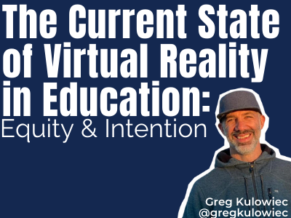by Greg Kulowiec
It appears that there are countless options emerging, practically on a daily basis in the Virtual Reality space in education. Yet, there is also a clear disparity between the quality and equitable access to certain types of virtual reality experiences. At scale, schools that have access to virtual reality class kits for consumption are typically working with a Google Expeditions kit (or similar). Quite frequently, when I work with teachers with this setup, there are two problems that emerge:
- The devices (typically provisioned Android phones) either can’t get onto the school network or are not given access.
- The kit is viewed as a tool to access Google Expeditions content for student consumption.
This traditional and somewhat common entry point to virtual reality highlights two problems. The challenge here is that both explicit obstacles may be beyond the scope and ability of the practicing classroom teacher to overcome. Yet, there are underlying and slightly more pressing concerns. Equity regarding the quality of devices and the purpose and intention of virtual reality in the classroom. With regards to the first concern, there is a spectrum of virtual reality use in the classroom that I like to reference when painting a picture about what virtual reality can look like in schools.
The purpose of this framework is to help start a conversation around the intention and impact of virtual reality in education. There is of course no inherent problem with Low-Fidelity consumption, but if that is the pinnacle of use, we are missing opportunities for students to create, tell stories and work with the medium. At this point, much of the work around virtual reality in schools falls into the low-fidelity consumption quadrant. There are of course environments with high end headsets where students can engage in high-fidelity experiences, but they are often limited in terms of access at scale due to cost. Again, this is not to say that there are not environments with high functioning, high-fidelity virtual reality programs in schools. My experience and observation running virtual reality workshops across the country with EdTechTeacher point to the low-fidelity consumption as the baseline of use at this point.
Continuing to work through this framework, there is often a general perception that the only type of creation possible is high-fidelity through the use of tools such as Unity, Tilt Brush with high end headsets. And while there are classrooms across the country that have students creating with Unity (and I anticipate this number growing), it is common that educators have not been exposed to, or are unaware of the creation capacity readily available in their classrooms with the devices that are currently accessible to their students. With this increased awareness, we can start to chip away at both obstacles stated earlier. While the challenge of equity can not be addressed when one student has access, support and an environment that supports high-fidelity creation and the other does not, we can create equitable access towards the concept of creating with VR across schools, classrooms and devices.
To help bring awareness to the ability for students to create in virtual reality using tools that are currently more accessible and abundant than a set of Oculus Quests in schools, we have the Virtual Reality Creation Kit. Through a combination of the tools, platforms and hardware outlined below, students can begin to create, tell stories, interact with and share their understanding through virtual environments. Of course, the kit outlined below does not allow for the quality of VR creation available through high-fidelity setups. However, at this point I think it is worth considering the opportunities that do exist and are accessible across many classrooms.
What is the current state of virtual reality in schools? I feel comfortable stating that we are the infancy of this technology in education and if we are to see it mature to it's full potential, to problems must be addressed:
- Intention & Purpose of VR programs - consumption & creation
- Equitable Access to both low and high fidelity creation tools
Good luck creating and please share your thoughts with me on the current state of Virtual Reality in education at greg(at)edtechteacher.org or on social media @gregkulowiec
If you are interested in exploring both virtual reality and augmented reality, consider joining Greg in a full day workshop.
Visit edtechteacher.org/arvrworkshop to learn more.

